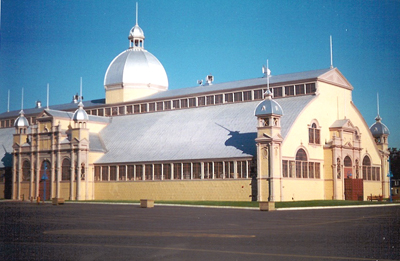Aberdeen Pavilion National Historic Site of Canada
Ottawa, Ontario

Aberdeen Pavilion
© Parks Canada / Parcs Canada, 1995
Address :
1015 Bank Street / Lansdowne Park, Ottawa, Ontario
Recognition Statute:
Historic Sites and Monuments Act (R.S.C., 1985, c. H-4)
Designation Date:
1983-06-13
Dates:
-
1898 to 1898
(Construction)
Event, Person, Organization:
-
Earl of Aberdeen
(Person)
-
Moses C. Edey
(Architect)
Other Name(s):
-
Aberdeen Pavilion
(Designation Name)
-
Cattle Castle
(Other Name)
Research Report Number:
1983-016
Plaque(s)
No plaque in place, recommended location: Ottawa, Ontario
This grand exhibition building was erected in 1898 by the Dominion Bridge Company for the Central Canada Exhibition Association. Designed by the Ottawa architect, Moses C. Edey, it was named to honour the incumbent Governor General, the Earl of Aberdeen, a staunch supporter of the agricultural fair movement. Also known as the Cattle Castle, it is the oldest surviving example of its type in the country. With its elaborate pressed metal ornamentation, a whimsical mix of classical and agricultural motifs, the structure evokes both the festive spirit and serious purpose of the 19th century fair.
Description of Historic Place
Successfully combining the practical with the fanciful, the Aberdeen Pavilion captures the spirit of the fairground. Its voluminous interior space, well-lit by many windows, is an ideal venue for exhibitions of all kinds, while its over-the-top exterior of sweeping roof, dome, corner towers and classical detail embodies the holiday atmosphere of a fair. The building is located in the midst of Lansdowne Park, Ottawa’s downtown fairgrounds. The designation refers to the building on its footprint.
Heritage Value
Aberdeen Pavilion was designated a national historic site of Canada because it is the only large-scale exhibition building in Canada surviving from the 19th century.
This grand exhibition building was erected in 1898 by the Dominion Bridge Company for the Central Canada Exhibition Association. Designed by the Ottawa architect, Moses C. Edey, it was named to honour the incumbent governor general, the Earl of Aberdeen, a staunch supporter of the agricultural fair movement. Also known as the Cattle Castle, it is the oldest surviving example of its type in the country, with its elaborate pressed metal ornamentation, a whimsical mix of classical and agricultural motifs, the structure evokes both the festive spirit and serious purpose of the l9th-century fair.
Source: Historic Sites and Monuments Board of Canada, Minutes, June 1983 and November 1991.
Character-Defining Elements
Aspects of this site which contribute to its heritage character include: those elements which speak to its qualities as a large-scale exhibition building of the late 19th century, namely, its light-weight and structurally innovative construction of structural steel covered with pressed metal and glass, its large, uninterrupted interior volume so suitable for exhibitions, its location on the site that has been used for exhibitions of various kinds for over a century, and its fanciful and festive architectural decorations such as the dome decorated with swags and garlands, the eclectic classical detail, the corner towers, and the curved roof with monitor windows.